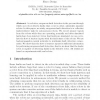Free Online Productivity Tools
i2Speak
i2Symbol
i2OCR
iTex2Img
iWeb2Print
iWeb2Shot
i2Type
iPdf2Split
iPdf2Merge
i2Bopomofo
i2Arabic
i2Style
i2Image
i2PDF
iLatex2Rtf
Sci2ools
111
Voted
ECAL
2007
Springer
2007
Springer
Exogenous Fault Detection in a Collective Robotic Task
In robotics, exogenous fault detection is the process through which one robot detects faults that occur in other, physically separate robots. In this paper, we study exogenous fault detection in a collective leader-follower task for autonomous robots. We record sensory inputs from the robots while they are operating normally and after simulated faults have been injected. Given that faults are simulated, we can correlate the flow of sensory inputs with the fault state of the robots. We use back-propagation neural networks to synthesize fault detection components. We show that the flow of sensory inputs is sufficient information for performing exogenous fault detection, that is, we show that the leader robot is capable of detecting faults in the follower robot. All results are based on experiments with real robots.
Related Content
| Added | 18 Oct 2010 |
| Updated | 18 Oct 2010 |
| Type | Conference |
| Year | 2007 |
| Where | ECAL |
| Authors | Anders Lyhne Christensen, Rehan O'Grady, Mauro Birattari, Marco Dorigo |
Comments (0)

